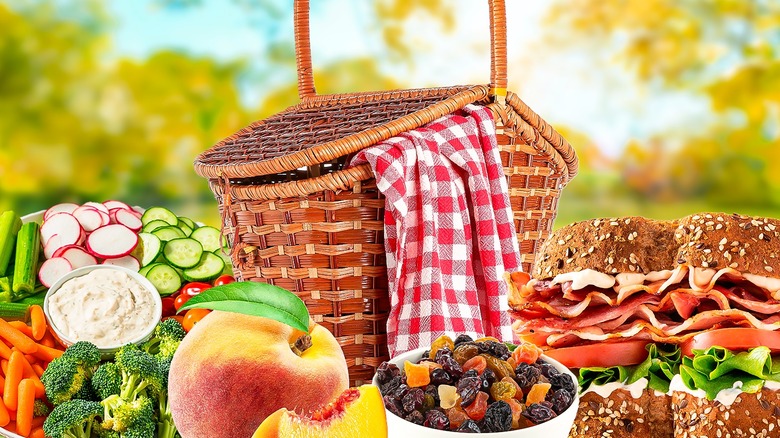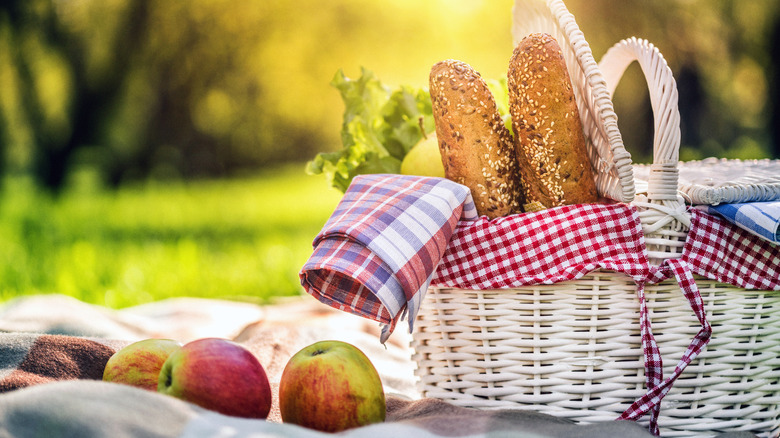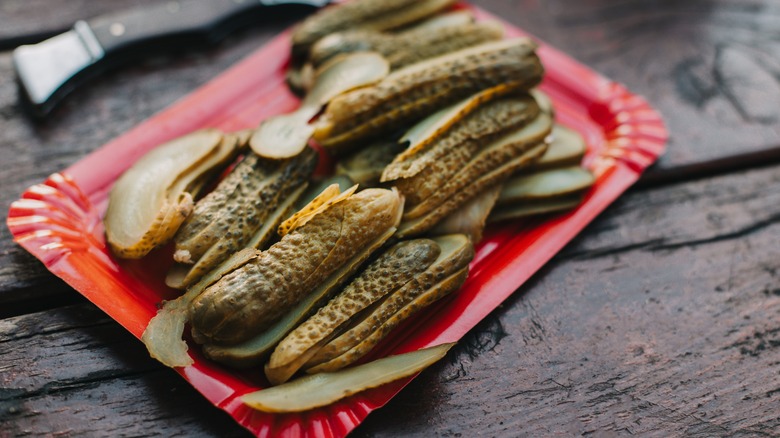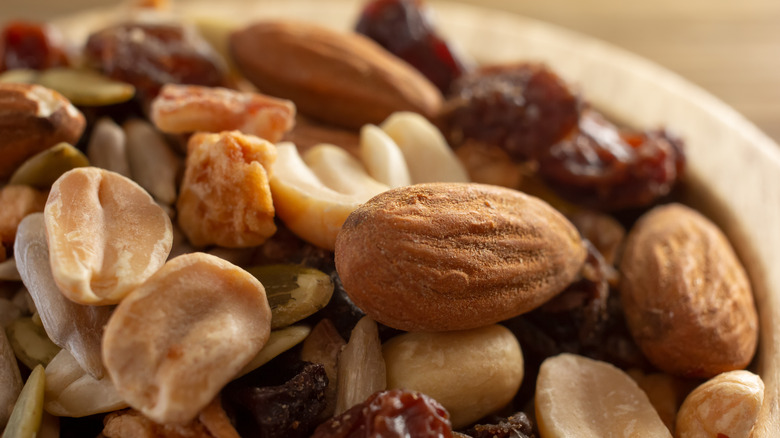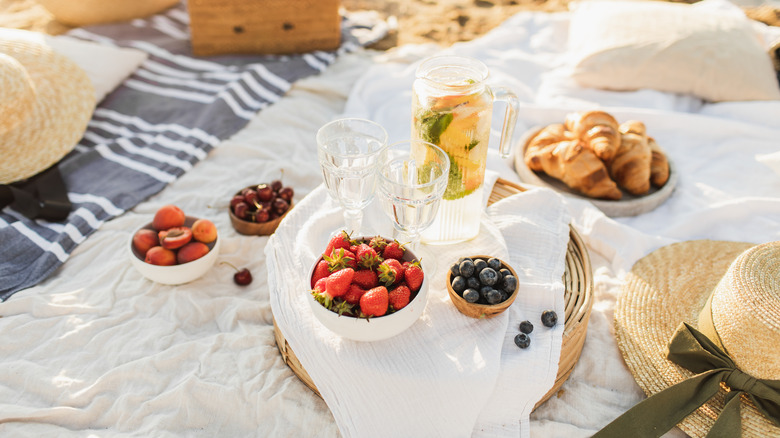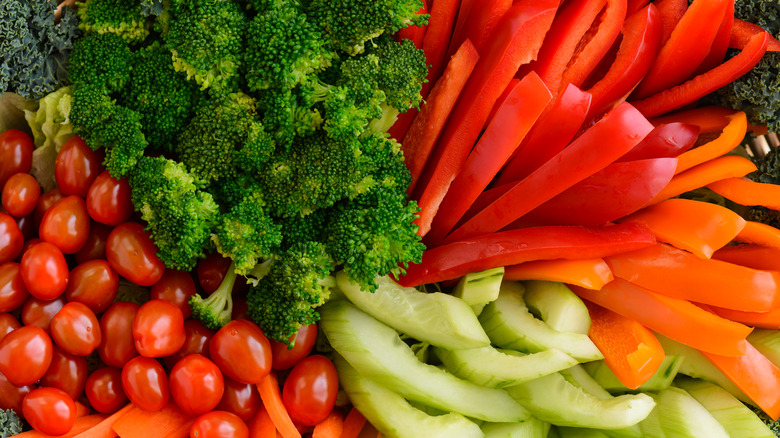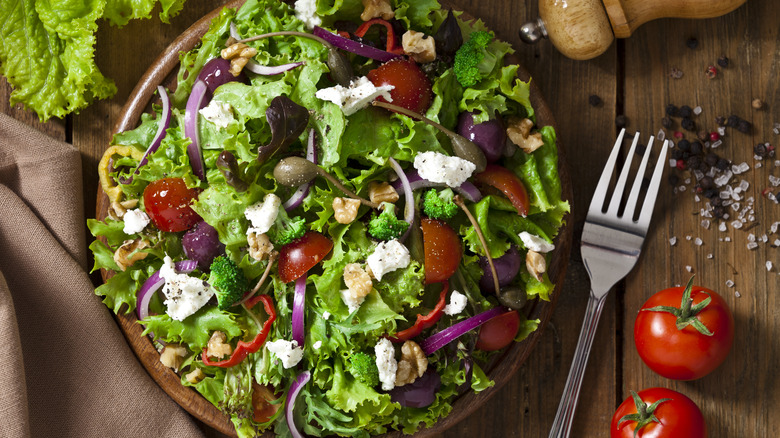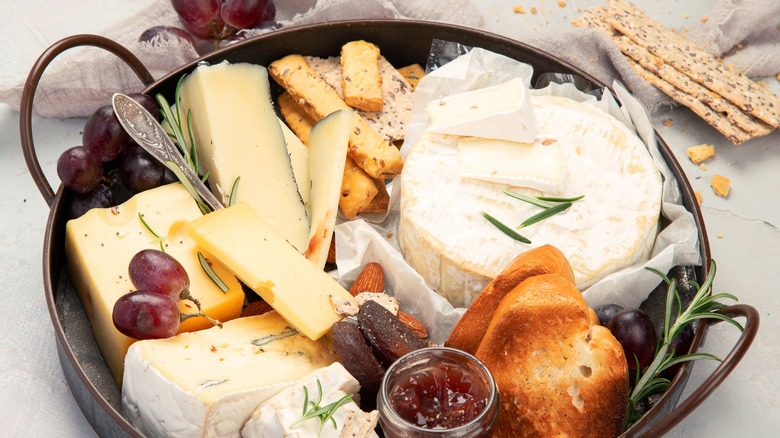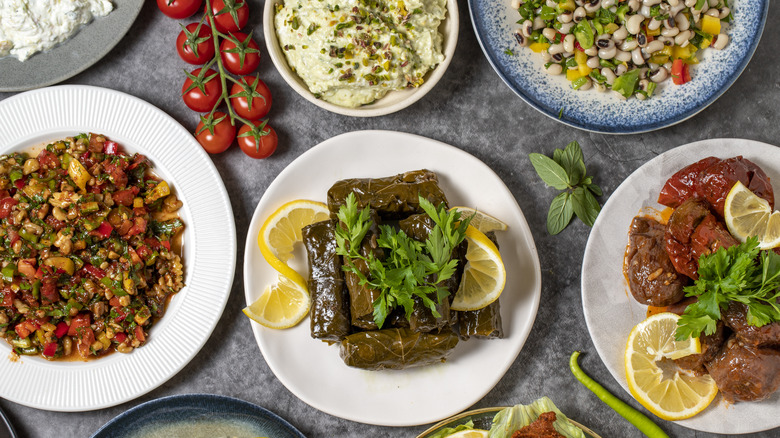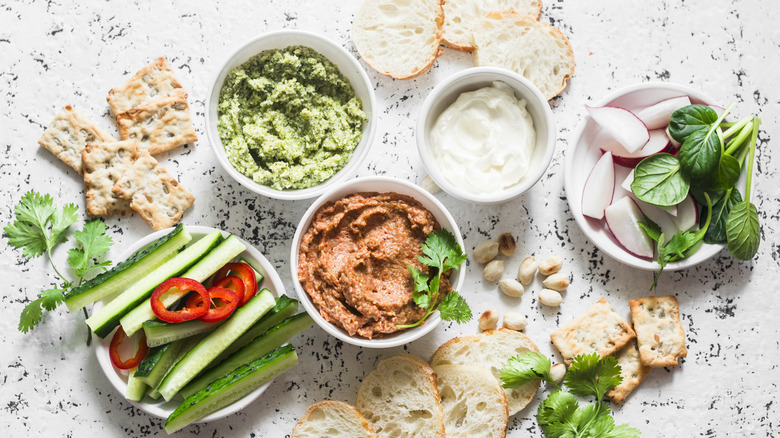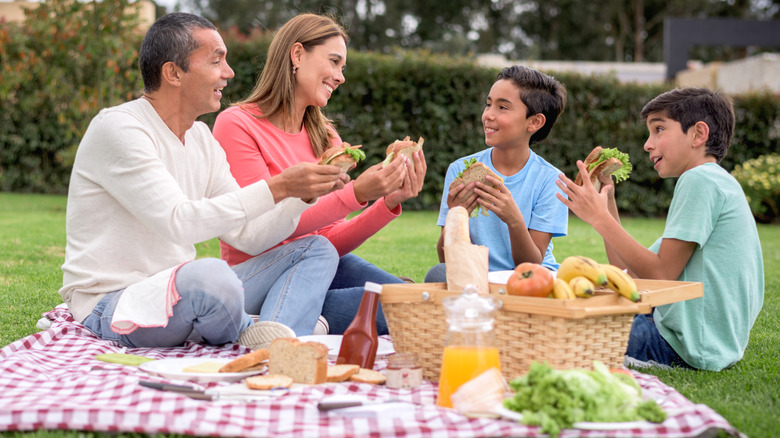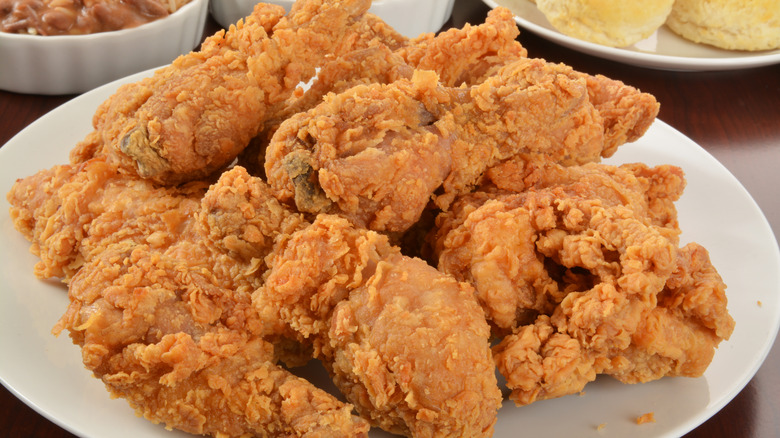The Best Picnic Food To Pack In Order To Prevent Food Poisoning, According To An Expert
Going on a picnic is one of the great summertime traditions. Spending an afternoon out in the open air, lounging on a blanket as the kids roister around, basking in the sunshine or cooling in the shade: It's the stuff that dreams and memories are made of.
Of course, food figures largely into the whole experience, as well. And that raises some issues, because while most of us enjoy sitting out in the sun, our foods don't. Ants are the stereotype threat to a picnic, but food-borne illness is a bigger concern. As anyone who's had the experience will tell you, it is (ahem) no picnic.
If you've wondered what are the best picnic food to pack, in order to avoid food poisoning or food-borne illness, I'm here to help. Aside from my experience as a trained chef and restaurateur, I've also been a certified food safety trainer in Canada and taught the topic. I'm drawing on my accumulated expertise in making these recommendations, starting with the lowest-risk foods going up from there. So dust off your picnic baskets, and let's get started.
Breads, flatbreads, crackers and chips are safe picnic staples
Most of us have a loaf of bread sitting in a cupboard or on the counter right now at room temperature, so you know they're a safe option for a picnic. Not only are they a useful option in their own right — sometimes a roll, or a piece of bread and butter, is all you need to make your plate feel complete — but they also can be paired with many of the other foods discussed here, in varying combinations.
Bread, rolls and flatbreads can all be used to make sandwiches from the meats and vegetables you've brought along. Flatbreads, crackers and chips of various kinds can all be eaten with dips, or on their own as snacks. Any kind of bread, flatbread or cracker can also be paired with cheeses, meats, preserves, pickles or condiments to make up the portable equivalent of a charcuterie plate. How simple or sophisticated you make it is entirely up to you.
Bread and crackers pose no meaningful risks from the food safety perspective. The only potential "gotcha" is accidentally packing along a loaf that's gone moldy, and those are easy to spot. Otherwise, any risk of illness comes from the foods you eat with your bread, rather than the bread itself.
Pickles, relishes and preserves make a picnic pop
Some of the safest options to bring along on a picnic are preserved foods of various kinds. Whether they're marinated, pickled, brined, canned or packed in syrup, they've all been prepared for the specific purpose of remaining food safe for extended periods, which makes them perfect for picnics.
Aside from their durability, all of those foods bring a concentrated pop of flavor to your picnic. Pickles or a jar of marinated vegetables can brighten up a spread of salads, cold meats or sandwiches. Relishes and chutneys bring zest to trays of cold cuts, and fruit preserves make a fine dessert when spooned over sweet breads, biscuits or small cakes.
These foods present very minimal risk of food poisoning or food-borne illness, as long as they're freshly prepared or newly opened at the time of the picnic. While illnesses resulting from preserved foods are rare, they can be serious. Home-canned foods in particular are a potential botulism hazard, if they aren't prepared, according to USDA guidelines.
Nuts, dried fruit and trail mix are proven and reliable outdoor foods
If you were involved in scouting as a kid, you probably ate your share of gorp, aka "good ol' raisins and peanuts." Nuts and dried fruits, and the trail mixes made from them, are some of the most proven and reliable foods to bring along on a picnic.
For one thing, they're a nutrient- and calorie-dense snack. If your picnics lean more to running, shouting, jumping and playing than lounging in the shade, the kids in the group (and any adults supervising them) will need this kind of energy sustaining pick-me-up. They're tasty, they're sustaining, and they'll keep you from getting "hangry" as you wait for the main picnic meal to be set up and served.
Dried fruit, nuts and trail mix pose a minimal risk from the food safety perspective. Nuts and seeds will become rancid over time if they're not stored properly, but they'll also taste bad and you will usually know not to eat them. Fungal toxins, most notably aflatoxins, are more of a concern. They won't necessarily make you sick tomorrow, but they can attack your liver, cause cancer, and suppress your immune system. The answer to both threats is buying your nuts and trail mix from high-volume stores with lots of turnover, so they're fresh.
Fresh fruit rarely causes foodborne illness
Summer is the season when a lot of fruits and berries are at their very highest quality and lowest price, which means they're perfectly timed for picnic season. There's a lot to like about fruit as a picnic staple: It's good for you, it's packed with fiber and nutrients, and — important if they're along for the fun — kids love it.
Any fruit that's sturdy enough to stand up to being thrown into a bag is a good option for picnicking, from everyday apples and oranges to melons (because there's nothing like a big ol' watermelon on a hot day). Bananas and berries are relatively fragile, but you can bring them along successfully if you pack them carefully. Berries often benefit from being kept in a cooler, so they won't spoil.
While fruit isn't a prime candidate for spoilage and food-borne illness, there are some moderate risks. Berries, stone fruit and melons have caused food-related bacterial outbreaks, for example. Your best bet for prevention is to wash them carefully before leaving home, and to use a brush to thoroughly scrub cantaloupes or other rough-skinned melons. You should also pack along a separate knife for cutting fruit and melons, and not use it for anything else.
Veggie trays are a safe, non-perishable picnic option
All of the same arguments that can be made for fresh fruits also apply to vegetables (okay, the kids probably won't be quite as enthusiastic about veggies). They're not especially perishable, can handle some time out in the sunshine better than most foods, and like fruit you can snack on your veggies all afternoon without feeling weighed down or bloated.
Most supermarkets sell veggie trays or platters that are all ready to come along to your favorite picnic spot, or you can make your own from what you have at home. Sticks of carrot, celery and cucumber, spears of sweet bell peppers, cherry tomatoes, and florets of broccoli and cauliflower are all popular choices.
Your potential food safety risks with vegetables usually don't stem from perishability in the heat. Instead, recalls on things like cucumbers or spinach usually stem from contamination during growing, harvesting or shipping. Washing them before peeling or cutting them up is a useful safety measure (otherwise your knife or peeler can transfer bacteria from the skin to the rest of the vegetable. Visiting FoodSafety.gov before your picnic, to check for recalls or outbreaks, is a good idea. The dips you serve with the veggies raise questions of their own, but I'll circle back to those.
Pack along your favorite salads
Having already spoken up in favor of vegetables, you won't be surprised to hear me recommend salads, as well. Cold foods are always welcome on a hot summer's day, and salads are especially refreshing. Most are also light enough that you can still enjoy throwing a ball around afterwards.
Green leafy salads, grain-based salads, coleslaw and most others are all good choices for taking along to your next picnic. Ideally, you'd pack along a few salads in different styles, so there's plenty of variety.
There are a few risks to be aware of with salads. I see a lot of food recalls involving bagged, premade salads, so you'll need to watch out for those, as well as any recalls or outbreaks involving the produce items you like to use in your salads. Finally, there's the question of dressings. Mayonnaise isn't the high-risk ingredient you might think it is, but on the whole, you're better off to choose salads with a vinaigrette-style dressing (those aren't prone to spoiling in the heat) rather than a dressing that requires refrigeration.
Firm cheeses do well at a picnic
Picnics are all about cold foods, and cheeses are some of the most popular cold foods there are. They're versatile, go with almost any food you care to mention, and you can find them in flavors ranging from the mild and unobtrusive to the strongly pungent and challenging. To put it another way, there's one for every taste.
Not all cheeses are well suited to picnic-going, though. Fresh cheeses (ricotta, queso fresco and many others) are perishable in the summer heat, and are frequently the subject of recalls. They're susceptible to contamination during production, or unfortunate failures of the cold chain during shipping can cause problems. You may even contaminate them yourself accidentally if you've been handling other foods, especially meats. You should wash your hands (and any utensils) before touching the cheeses. If you won't have access to washing facilities, bringing hand sanitizer and spare utensils is a good idea.
The most reliable cheeses to picnic with are firm varieties that have been through some aging. They're not nearly as perishable, and their firmer textures make them less susceptible to contamination. Think in terms of cheddar and Monterey Jack, Swiss, gouda, feta and others along those lines.
Mediterranean and Middle Eastern finger foods are picnic-friendly
Most of the foods on this list are fairly traditional for picnics, hiking and other outdoor activities. This next pick is rather less so, at least in the North American context, but it's an easy call. The culinary traditions of the Mediterranean and Middle Eastern regions are big on both outdoor dining and finger foods, so many of their best-known specialties are ideally suited to your picnic table.
This includes things like stuffed vine leaves (dolmas), falafel, baba ghanouj, hummus, and the herbed balls of yogurt cheese known as labneh. Add in some tzatziki or similar yogurt-based dips, and a few pita or other flatbreads, and tabbouleh or fattoush salads, and you've got an entire themed picnic lunch right there.
Few of these foods pose any specific food safety threat. Labneh is safer than other fresh cheeses because of its acidity, and the vegetables and grains aren't especially perishable. It's still a smart idea to rest any high-protein dips like hummus or tzatziki on a cooler pack, just to be sure, but most of these foods can be considered worry-free.
Bring fresh salsas and cold dips
You may be really proud of your hot crab dip, but that doesn't mean it's a good choice for a picnic. Keeping hot foods at a food safe temperature of 140 F or higher is a real challenge in a grassy field; it's much easier to keep cold foods cold.
So your best choices for dips are almost always cold. The least perishable options are things like fresh salsa, which make heavy use of fresh vegetables and bacteria-inhibiting acidity. Dips based on sour cream or yogurt are also reasonably acidic, though they should still be kept cool. Dips without that acidity, including hummus and anything based on cream cheese, are also safest when chilled.
The safe way to do that on your way to the picnic ground is in a cooler, with bagged ice or gel packs to keep the food cold. You could also look for flat gel packs that can be used underneath the serving dishes, helping keep them cool even while they're sitting out on your blanket or a picnic table. That's what I used to do professionally when catering, or working a farmer's market. Some companies even make serving dishes that can be frozen, and used to keep foods cold as you serve them. Setting up a bowl filled with crushed ice is one more alternative, and with a bit of creativity you can dress up the bowl to make it attractive.
Sandwiches are an iconic picnic food...
A platter of sandwiches — or several of them — is one of the most iconic parts of a big picnic spread. Sandwiches are a pretty good choice from the food safety perspective as well, because you'll rarely get any kind of food poisoning from them if they're freshly made.
Not all sandwiches are created equal, of course. Some are made on soft bread, sliced into quarters, and piled high on the plate. Others use artisan breads and fillings, and some of us really love a platter of sliced-up sub sandwiches or open-faced appetizer-style offerings. The style of sandwich you prefer isn't really pertinent to food safety, but the fillings you choose definitely are.
A lot of popular sandwich fillings, including deli meats, canned meats and fish or poultry are perishable once they're out of their cans or out of the refrigerator. They should be kept in a picnic cooler, with bagged ice or frozen gel packs to keep them cold. Sandwiches filled with vegetables and firm cheeses are less susceptible to the heat, and are usually fine. The same goes for the kids and their PBJs, leaving aside the possibility of a peanut allergy (in which case you can use an alternative nut butter).
...And so are canned or shelf-stable meats, fish and poultry
Pickles and relishes aren't the only foods designed for durability. Canned, dried and other shelf-stable meats, fish and poultry can expand the range of foods you pack along to your picnic. Many canned meat or fish products can be served right from the can, as soon as they're opened, and premium canned fish in particular can be a sophisticated adult option. The same holds true for jerky and other dried meat products, like prosciutto.
Canned meats and fish can also expand the range of lunch options available to you. Many people would hesitate to make up a mayonnaise-based salad or sandwich filling if they knew it would sit in a warm spot for hours, but taking along the ingredients and assembling it right at the picnic ground changes the equation. Your spreads and condiments will be fresh from the cooler, and the canned ingredient newly opened, so this is a safe option as long as your hands and utensils are clean (once again, having hand sanitizer or a hand-washing option is very helpful).
Recalls of commercially canned or preserved foods are uncommon but they do happen. If you've already made a mental note to check for recalls and outbreaks before picnicking, you'll uncover those, as well.
Cold meats, fish and poultry are better picnic foods than hot
I've deliberately kept this list focused on cold foods rather than hot, because not all picnic areas provide the option of grilling. Also, cooking foods from raw introduces a whole other range of food safety risks, which would have made guide far too long.
That doesn't mean you need to pass on meats entirely, just that your focus should be on cold offerings rather than hot. They'll need to be kept in your picnic cooler until it's time to eat, and ideally be served with a cold pack under the plate, but those aren't challenging arrangements to make. Picnic-friendly options include cold fried or roasted chicken, sliced ham, smoked or cured fish, deli meats, and precooked sausages such as salami.
You'll need to recognize that these are the riskiest foods you'll bring along on your picnic, and handle them accordingly. Put them in your coolers first, and take them out last. Better yet, plan in advance how many coolers you want to use, and how you can pack the most perishable foods separately. If you have room, bringing extra ice or freezer packs in another cooler, to keep any leftovers cold on the way home, is a good idea. As with other perishable foods, serving them on top of a chilled gel pack (or on a bed of ice, depending on the food) will give you an extra margin of safety.
